Курсовая: Welcome to Russia
Project
Welcome to Russia!
Contents:
I. About Russia
1. State System of Russia
II. About Moscow
1. General Information
2. Natural and Economic Resources
3. Science
About Russia
Russia was the largest Republic in the former USSR. But now it has become an
independent State.
It is situated in the Eastern part of Europe and in the Northern part of Asia.
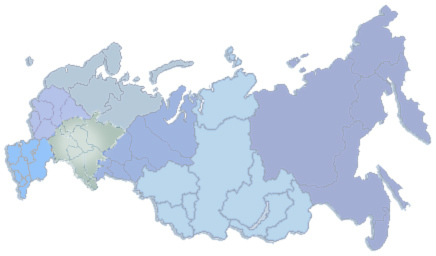
The country is washed by 12 seas and three oceans: the Pacific, the Arctic
and the Atlantic oceans. The seas are: the White Sea, the Barents Sea, the
Okhotsk Sea, the Black Sea, the Baltic Sea and others.
The climate in Russia varies from arctic in the north to continental in the
central part of the country and subtropical in the South. Winters are cold,
windy and snowy, especially in the northern part of the country. The coldest
point of the northern hemisphere, where temperatures are minus 70˚C, is
located in Siberia. Summers are hot and dry, especially in the South region
of the country, in such cities like Sochi, Anapa and others. Autumn usually
brings rains and fogs.
The land of Russia varies from thick forests to barren deserts, from high
peaked mountains to deep valleys. There are two Great Plains in Russia: they
are the Great Russian Plain and the West Siberian Plain. There are some
mountain chains. The biggest mountain chain, the Urals, separates Europe from
Asia. In Asian part of Russia we can find another big mountain chain, the
Altai. There are about 150 volcanoes in Kamchatka Peninsula, 30 of which are
active. One can find deserts in the Far East, Arctic zones of tundra in the
North. These territories are inhabited by various animals, birds and insects.
In the north of Russia live the walrus, seal, white bear, polar fox and
reindeer. In the forest zone live the bear, wolf, fox, lynx, sable, ermine,
elk, wild bear and in the Far East the tiger and leopard. Among the trees
growing in the European part of Russia are birch, pine and oak: in Siberia –
cedar, larch and fir trees and in the Far East – cork trees, lotus, ginseng
and lianas.
There are very many rivers in Russia, the longest of them are the Volga in
Europe and the Yenissei and the Ob in Asia. The world’s deepest lake - Lake
Baikal, with the depth of 1600 metres, is situated in Russia, too. Its water
is the purest in the world.
Russia borders on many countries: Norway and Finland in the north-west,
Estonia, Latvia, Belarus and the Ukraine in the west, Georgia and Azerbaijan
in the south-west, and Kazakhstan, Mongolia, China in the south
The capital of Russia is Moscow and it is also one of the main political,
scientific, industrial and cultural centres. It’s population is about 10
million people. Other big cities are St. Petersburg, Sverdlovsk, Samara,
Omsk, Novosibirsk and many others.
Russia has population of about 150 million people of over a hundred
nationalities. Nearly one hundred languages are spoken in the country. The
European part of the country is densely peopled, and most population live in
cities and towns and their outskirts.
Russia is a highly-industrialized-agrarian country. Its vast mineral
resources include oil, natural gas, coal, iron ore, nickel, zinc, lead,
aluminium, gold, diamonds, zinc and almost all other minerals. Russia has the
world’s largest oil and natural gas resources. Three-quarters of the
country’s mineral wealth are concentrated in Siberia and the Far East.
Approximately 10 million people are engaged in agriculture and they produce
half of the region’s grain, meat, milk and other dairy products. The largest
granaries are located in the North Caucasus and the Volga and the Amur
regions.
Russia has very long and rich history. That’s why we have many different
customs and traditions. For example, there are many villages in Russia famous
for their specific crafts: painted boxes in Palekh, wooden tableware in
Khokhloma and toys in Dymkovo. Log houses, usually decorated with wood
carving are typical for Russian villages. People in Russian villages
performed traditional Khorovods (a kind of round dance) and chastushki (folk
chanted rhymes) and rode in troikas (carriages drawn by teams of three horses
abreast) and, of course, village residents still prefer to drink tea from
samovars. Traditional Russian Cooking includes porridges, pancakes, various
aspics, cabbage, chicken and fish soup and kvass (a beverage made from
fermented rye bread). Siberian cuisine has such dishes as stroganina (frozen
fish) and pelmeni (meat-filled dumplings).
Our country has always played one of the leading parts in the world politics
and economics. But, at present, there are a lot of problems in the national
economy of the Russian Federation. The industrial production is decreasing.
The prices are constantly rising, the rate of inflation is very high. People
are losing their jobs because many factories and plants are going bankrupt.
State System of Russia
The Russian Federation, or the Russian Federative Republic, is set up by the
Constitution of 1993.
Under the Constitution Russia is a presidential republic. The federal
government consists of three branches: legislative, executive and judicial.
Each of them is checked and balanced by the President.
The legislative power is vested in the Federal Assembly. It consists of two
chambers. The Upper Chamber is the Council of Federation: the Lower Chamber
is the State Duma.
Each chamber is headed by the Speaker. Legislature may be initiated in either
of the two Chambers. But to become a law a bill must be approved by both
Chambers and signed by the President. The President may veto the bill.
The President is commander - in chief of the armed forces, he makes treaties,
enforces laws, appoints ministers to be approved by the Federal Assembly.
The executive power belongs to the Government headed by the Prime Minister.
The first action of the Prime Minister on appointment is to form the Cabinet.
The judicial branch is represented by the Constitutional Court, the Supreme
Court and the regional courts.
The members of the Federal Assembly are elected by popular vote for a four-
year period.
Today the state symbol of Russia is a three-colored banner. It has three
horizontal stripes: white, blue and red. The white stripe symbolizes the
earth, the blue one stands for the sky, and the red one symbolizes liberty.
It was the first state symbol that replaced the former symbols in 1991. The
hymn of Russia was written by Alexandrov. A new national emblem is a two-
headed eagle. It is the most ancient symbol of Russia. It originates from the
heraldic emblem of the Ruricovitches. All these symbols are official. They
have been approved by the Federal Assembly.
Russia is famous for great scientists such as Lomonosov, Mendeleev,
Tzyolkovskii, Popov, Sacharov, Korolev, writers – Pushkin, Tolstoy,
Dostoevsky, Lermontov, Chekhov, painters, actors. And also is famous for the
great discoveries as the first man in the space, the discovery of the
hydrogen bomb which contributed to the development of society and world.
About Moscow
General Information
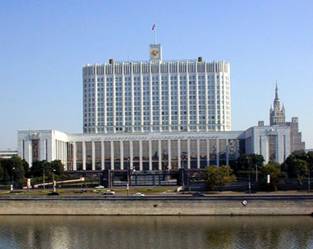
Moscow is the largest economic, political, and scientific center of Russia.
The city's wealth of scientific, technical and industrial potential form the
basis of its economy.
The many large industrial enterprises that operate within the city represent
various industry sectors, including ferrous and nonferrous metallurgy,
engineering and metalworking, building materials, light industry, food, and
defense, among others.
Major car manufacturing, aircraft, and engineering plants, as well as
textile- and food-industry and municipal construction enterprises, are
located in Moscow. Moscow is also one of the largest transportation centers
in Russia and Eastern Europe.
Since 1990, Moscow has been the acknowledged leader of Russian economic
reform. The increased influence of Moscow's economy in the new Russian
economy is characterized by a substantial increase in Moscow's share in the
revenues and expenditures of the RF budget.
Natural and Economic Resources
Moscow is situated in the center of the Russian plain, covering the
interfluve of the Volga and Oka rivers, the Smolenskaya and Moskovskaya
uplands, the Klinsko-Dmitrovskaya Ridge, and the bogged Meshcherskaya Lowland
(with elevations up to 285 m).
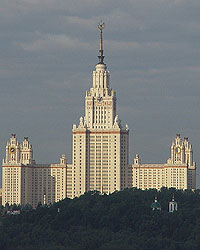 1. The Smolensko-Moskovskaya
1. The Smolensko-Moskovskaya
moraine upland is developed on the northwest of Moscow. It has smooth
topography with altitudes of 175-185 m.
2. The Moskvoretsko-Okskaya moraine-erosion plain in courses into the city
from the south and is called the Teplostanskaya Upland. It is an undulating
erosion surface with altitudes of 200-250 m composed of Mesozoic rocks
covered by loams. It is cut by deep ravines and flat-bottom valleys.
3. The Meshcherskaya outwash plain is situated on the east of the city. It is
a flat sandy lowland with isolated moraine uplands. Altitudes are up to 160
m.
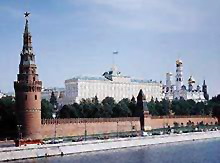 The soils are sod-podzolic, light gray in color.
The soils are sod-podzolic, light gray in color.
Moscow has a moderate continental climate with an average July temperature of
+17°C and an average January temperature of -10°C. Precipitation ranges from
450 to 650 mm annually.
The Moscow River is the city's main waterway, traversing it from northwest to
southeast. The length of the river's course within the city limits is almost
80 km. About 50 tributaries flow into the Moscow River, the largest one being
the Yauza River.
The city's park system is based on 17 forest parks; 17 city, 58 district, and
9 specialized parks; 14 gardens; about 700 public gardens; and 100
boulevards.
Science
Moscow has built up a stable educational system that reacts quickly and
sensitively to the educational requirements of various strata and groups of
the population and offers city residents a wide range of educational
services.
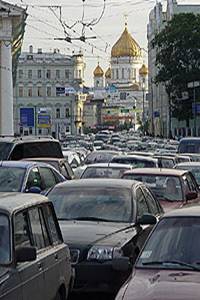
The Moscow Government has adopted a special municipal program called
"Modernizing Education in Moscow," which defines the further course of
development of education for 2002-2004.
A total of 3767 institutions operate in the Moscow Education Committee
system. There are more than 1.3 million students in educational institutions,
along with nearly 200 000 teachers, industrial training specialists, tutors,
medical personnel, and administrators.
During preparations for the 2001-2002 school year, a considerable amount of
work was done to develop and rationalize the existing system of educational
institutions with regard for the population's requirements. As a result,
innovative schools have been set up in each of Moscow's administrative
districts: a cadet school in the Eastern Administrative District; education
centers in the Southeastern, Eastern, Western, and Southern administrative
districts; a pro gymnasium in the North-eastern Administrative District;
gymnasia in the Southeastern, North-eastern, and Northern administrative
districts; a lycee in the Southern Administrative District; general education
schools with advanced study in various subjects; and a center in the Eastern
Administrative District for social and work adaptation and career guidance
for orphaned children and children left without parental care.
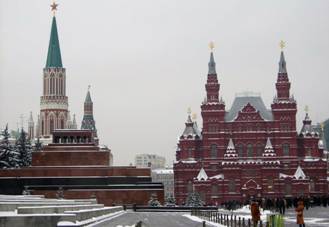 In 2001, new educational
In 2001, new educational
institutions for children needing psychological and medical assistance for
educational and social problems, as well as supplementary educational
institutions, were established as an adjunct to the existing ones.
In order to meet the requirements of highly motivated children, gymnasium
classes (in addition to the existing 225) have been set up in 34 general
educational institutions and lycee classes, in 7 (in addition to the existing
73). Instruction based on ethno cultural education programs has been
organized in 5 general educational institutions (in addition to the existing
65).
In order to provide children with a well-rounded upbringing and to meet
family needs, 150 groups for young children and 197 short-duration
development groups for children not attending preschool institutions have
been set up.
In accordance with the Moscow Government's Program, 1474 million rubles have
been spent to provide 1 006 900 students with free meals and compensation for
meals. Another 368.1 million rubles have been earmarked for health-
improvement measures in the Moscow school system.
A plan for publishing and distributing textbooks has been fulfilled. Five
million textbooks and literary texts have been delivered to the capital's
schools, for which 360 million rubles were allocated from the city budget. In
addition, more than 250 000 texts at a total cost of 8 million rubles were
sent to Russian-language schools in the CIS and the Baltic States in 2001.
Literature:
1. Russian-English dictionary
2. English-Russian dictionary
3. English for Teenagers
Shcheglov Ivan, 10 “V”